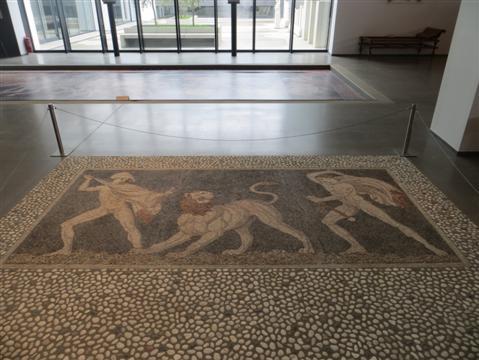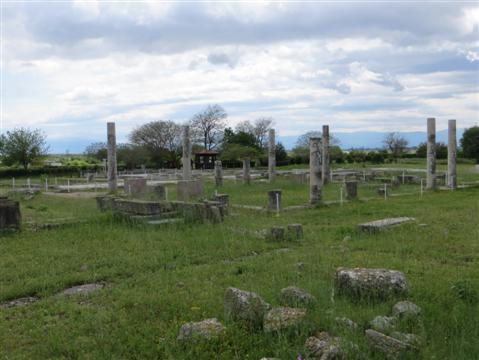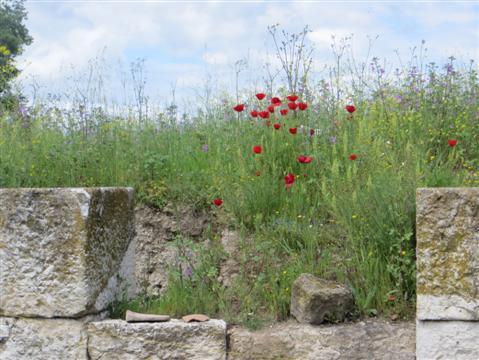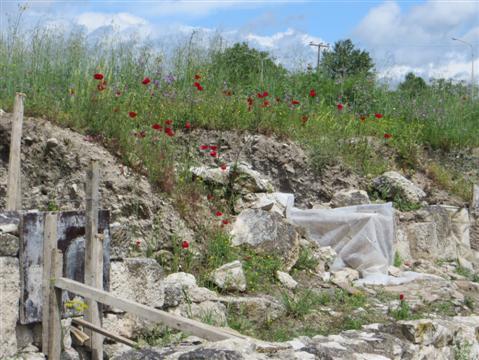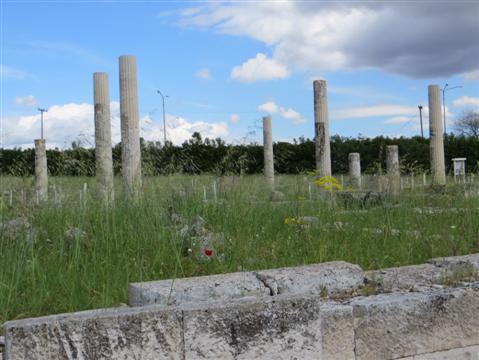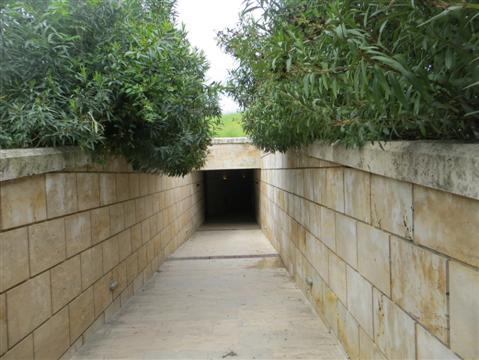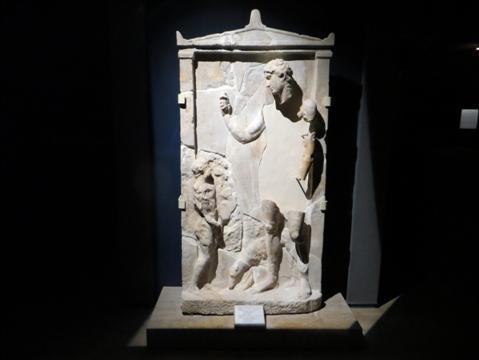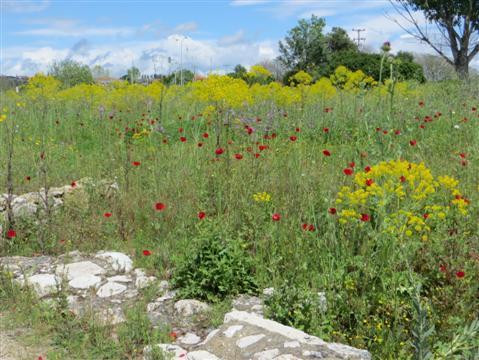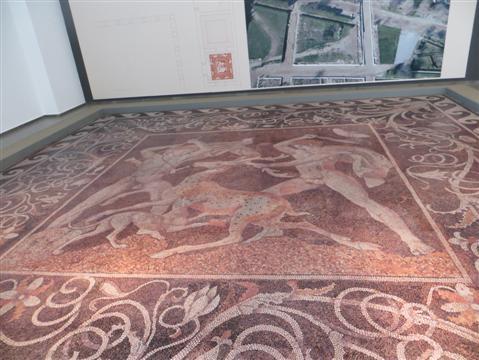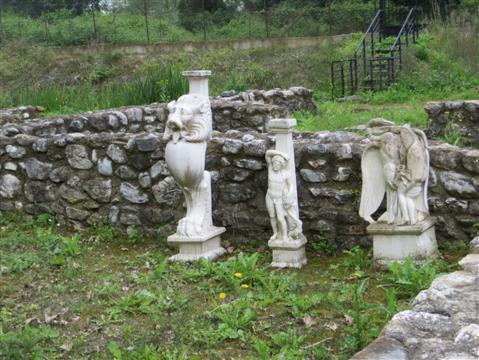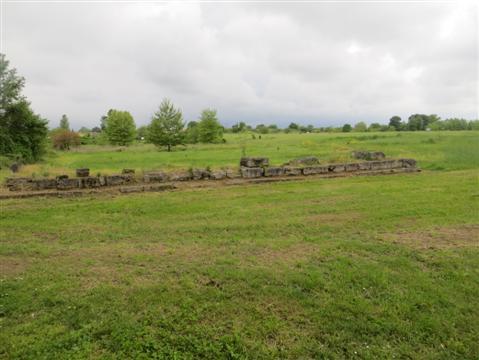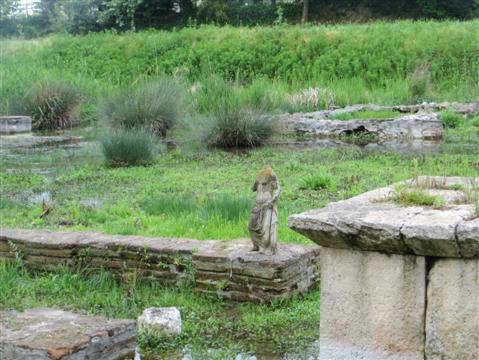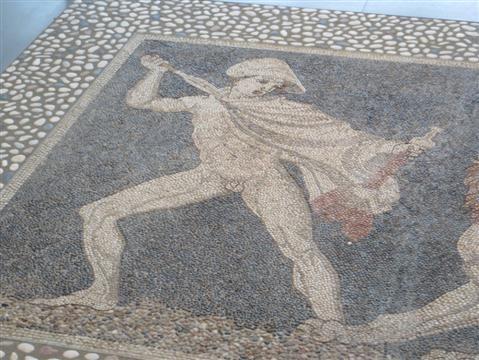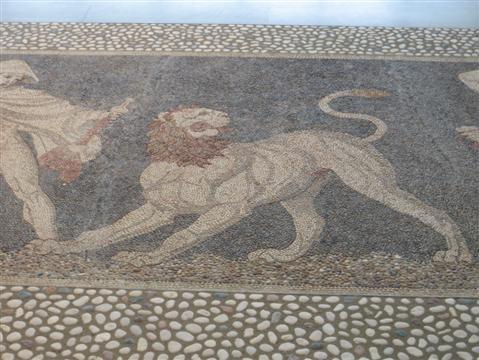Before there was Alexander the Great, there was Alexander the young prince, gallivanting round the boondocks of Macedonia, taming the mighty steed Bucephalas, learning at the feet of the great philosopher Aristotle, even possibly master-minding his own father's assassination - all at sites within easy reach in the Greece of today.
A museum now stands within a good slingshot's throw of the huge hilltop palace in the ancient capital of Pella where Alexander was born on July 20, 356 B.C. to King Philip II of Macedon and his fourth wife, Olympias, daughter of King Neoptolemus I of neighbouring Epirus.
Alexander the Great's statue in modern Pella's main square
According to the Greek historian Plutarch, writing some 400 years after the event, on the eve of the consummation of the marriage Olympias dreamed that a thunderbolt struck her womb, indicating that Zeus, king of the gods, was Alexander's father.
Be that as it may, the site of the 14-acre palace, an area about 10 times as large as the Vatican City, is currently closed for excavation and restoration work. The museum, though, contains a marble head of Alexander and a statuette decking him out with the horns and tail of Pan, god of the mountain wilds and mate of the nymphs.
Lion hunt mosaic in Pella museum
In real life Alexander may have lacked such nymph-pleasing attributes, but the short, sturdy future master of the universe had other unusual attributes, including two-coloured eyes - one brown, the other blue - and a neck bent slightly to the left.
Other museum artifacts include large multi-coloured mosaics found on the floors of ruined houses, including lion and stag hunts and the rape of Helen of Troy, tons of coins stretching down to Roman times, pottery, gilded clay buttons, golden myrtle wreaths, gold thread, graves with skeletons - and a drinking and libation vessel shaped like a phallus. Lord alone knows what you'd look like when you're thirsty.
Part of Pella agora
It was in Pella that young Alexander grew towards manhood. At age 12 he tamed the hitherto indomitable Bucephalas, arguably the most famous real-life steed in antiquity, to the amazement of King Philip and the Macedonian courtiers.
Dad was in fact so impressed by junior's overall prowess that after entrusting him for three years to the scholarly care of Aristotle at the Temple of the Nymphs in Mieza, a dozen or so miles from Pella, he made him regent at age 16 while he was away waging war in Thrace.
Flowers and grass cover agora
It was then that the the once-and-future Great undertook his first military mission, subduing rebellious tribes. Later he joined his father in defeating Athens and Thebes as Philip planned to capture Asia, too.
If Alexander were to return to his capital today, riding across the fields astride Bucephalas, he might vaguely make out the outlines of the 17-acre agora market, its scant calf-high walls and fallen pillars pushing up through carmine poppies, yellow and purple flowers, and long grass. He might show a flicker of recognition at the statue of himself astride Bucephelas in modern Pella's main square.
But he'd search in vain for the large port. The sea has long since fled due to silting from the rivers. The former seaside capital now lies 15 miles inland.
The agora today
Back then, though, in Pella, clouds were looming on the horizon of the once-and-future Great. Philip took Cleopatra, niece of the Macedonian general Attalus, as his seventh wife, endangering Alexander's path to the throne, since a son from the new union would have priority as a full-blooded Macedonian.
At the wedding banquet, Attalus openly prayed that the marriage would produce a 'legitimate heir,' at which Alexander hurled a cup at his head. Philip, taking Attalus' side, charged at Alexander with his sword but slipped and fell.
Hereupon junior, showing a remarkable death wish, remarked: 'Behold the man who makes preparations to pass out of Europe into Asia, overturned in passing from one seat to another.'
The agora again
Coming quickly to his senses, he took his mother and fled, dropping off Olympias with her brother, King Alexander I of Epirus, and moving further away from Dad's ire to Illyria.
He returned only six months later when the feud was papered over. But his future throne was still tilting precariously, not only because Cleopatra gave birth to a son, Caranus, but because of suspicions that Philip might favour Alexander's older half-brother, Philip Arrhidaeus.
Aigai mound entrance
And here's where young Alex's tale reaches a climax, not in Pella, but in Aigai, the former Macedonian capital until King Archelaus founded Pella, a few dozen miles to the north, in 399 B.C. Aigai, by the modern Greek town of Vergina, had risen to prominence in the 7th century B.C. when Perdiccas I asked the Delphic oracle where he should build his capital. She told him: 'wherever the goats take you.'
Now I think she was just telling the old goat to get the hell out of her oracle, but he took her literally and pushed on up north, until he saw a whole horde of real goats rutting away in a field. Thus was Aigai born, derived from the Greek word for, well yes, goat.
Only picture taken in Aigai museum before being told photos are very verboten
Even after being replaced as capital Aigai remained a major dynastic centre for royal ceremonies and funerals. Thus was it that in October 336 B.C. Philip chose it to marry off Alexander's full sister, another Cleopatra, to her cousin, King Alexander of Epirus.
As he was entering the grand amphitheatre to accompany the blushing bride down the aisle, Pausanias, one of his seven bodyguards, charged forward and stabbed him to death in an 'Et tu, Brute' moment before there was ever a Brutus. Pausanias was a right klutz, though, as he then went and tripped over a vine trying to escape and was killed by some of Alexander the future Great's friends.
Another Pella view
Ancient historians differ on the motives. Some say Pausanias had been insulted by Attalus, now Philip's father-in-law, others that Pausanias was furious at being jilted in a gay relationship with Philip by a younger man, yet others that the future Great and Mamma Olympias orchestrated it all to ensure junior's accession to the throne, a view an archaeologist at the site today finds totally in sync with Alexander's character.
Stag hunt mosaic, Pella
Be that one, too, as it may, Alexander was proclaimed king and accordingly proceeded to kill Caranus and any other potential rival.
And that was that, more or less, for Aigai until November 8, 1977, when Greek archaeologist Manolis Andronikos found a tomb in a hill here so splendidly endowed that he said it could belong to none other than Philip II for whom historians record that Alexander put on a magnificent funeral ceremony.
Ruins of Dion
Today, an artificial mound has been built over the four tombs that were found next to each other, merging them with an under-the-mound museum in an exceptionally well executed project that is rightfully on the United Nations' list of World Heritage Sites.
The pièce de résistance is, of course, Tomb II, the one ascribed to Philip. It's like a small temple with columns beside its marble door. Above is a frieze with blue stripes over red bases, and above that another frieze depicting a vivid hunting scene with Philip and Alexander chasing lions and boars in what must have been brilliant colours and contours that can still be made out.
More Dion ruins
The tomb has two chambers, in the smaller of which was buried Mida, one of Philip's younger wives who according to custom followed her husband, willingly they say (a likely tale!), onto the funeral pyre.
The artifacts in the museum are truly breathtaking, showing the enormous expense junior, now king and about to be great, went to in paying homage to the Dad he may well have done in.
There's Philip's magnificent gold-embroidered suit of armour, his crested helmet, his huge gold-decorated shield; enormous green copper utensils and bronze lamps; silver vessels for a feast; gold and purple cloth; ornate banquetting benches; burgeoning gold wreaths of oak leaves, one with 313 leaves and 68 acorns which the dead king wore on his pyre; the gold larnax or square box that contained his bones and skull, which shows an old war injury Philip was known to have suffered.
Where Alexander sacrificed and prayed before Asia campaign
Barely anointed king, Alexander now had to deal with a series of revolts throughout Greece, one of the most serious of them led by Thebes, which he then proceeded to destroy, killing everyone in sight - men, women and children - making himself a prime candidate for the International Criminal Court (ICC) for war crimes had it existed then.
He still had one more place in Greece to visit before he stormed off to Asia astride Bucephalas on his crazed path to greatness, never to return as he notched up many a new indictment before a putative ICC.
A few dozen miles south of Aigai lies Dion, the sacred city of the Macedonians, its ruins spread over a vast area within direct view of Mt. Olympus, home of the gods. It was here in 334 B.C. that Alexander made lavish sacrifices at the sanctuary of Olympian Zeus on the eve of his megalomaniacal drang nach ostern.
Another Dion temple
This is where it was all sanctified, the prototype of the Scramble for Africa, of the Great Game in Central Asia, the quest to conquer the world.
The rest, as they say, is history. Not for nothing had Olympias drummed into her pride and joy's curly head that he was the son of Zeus.
Pella mosaic detail
Bucephalas carried Alexander to victory and greatness as far as present-day Pakistan, dying at the equine old age of about 30. Alexander himself died in Babylon at the young human age of 32 and 11 months, not even reaching the 33 years of another, later son of God.

